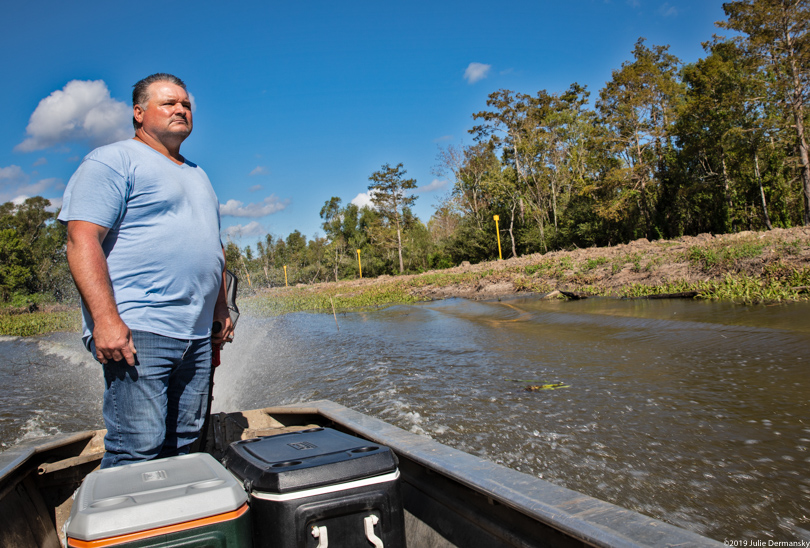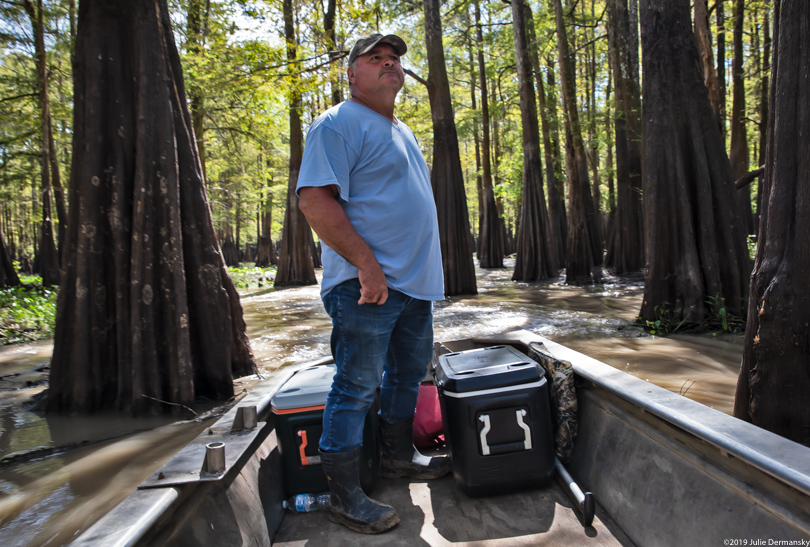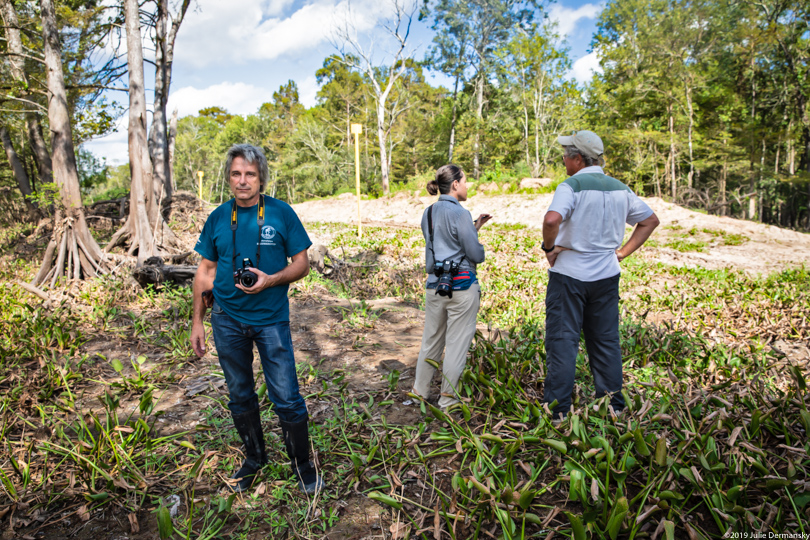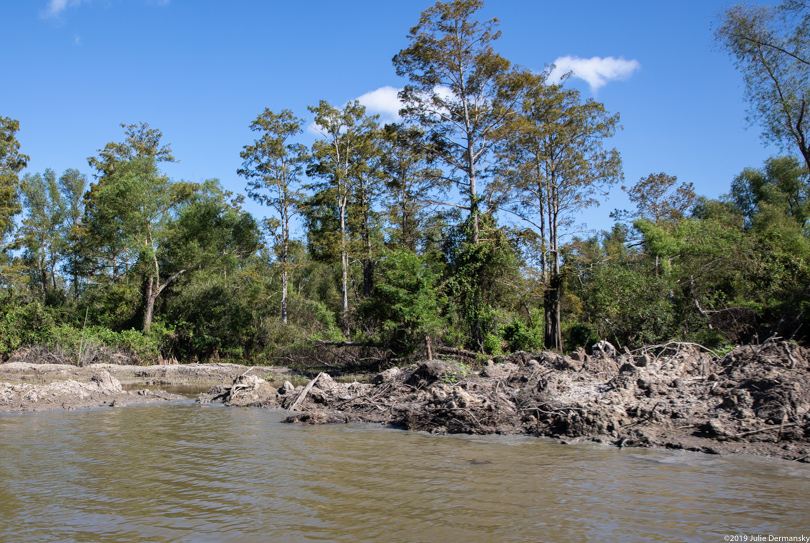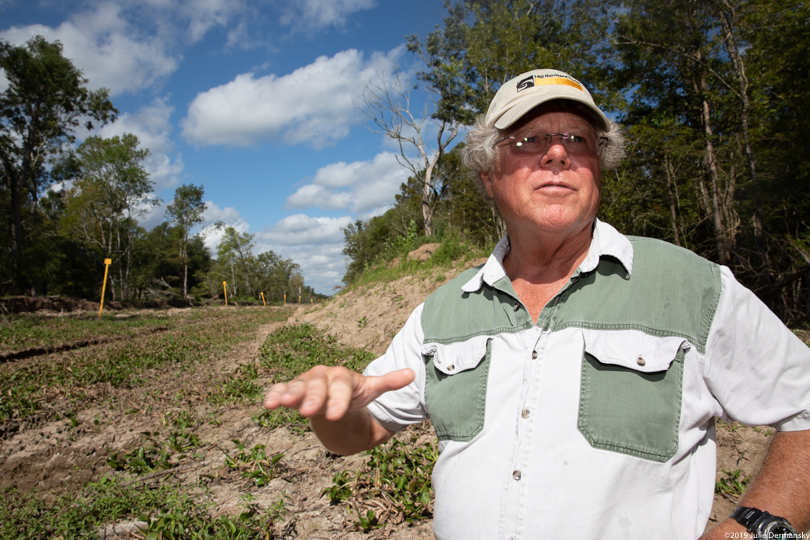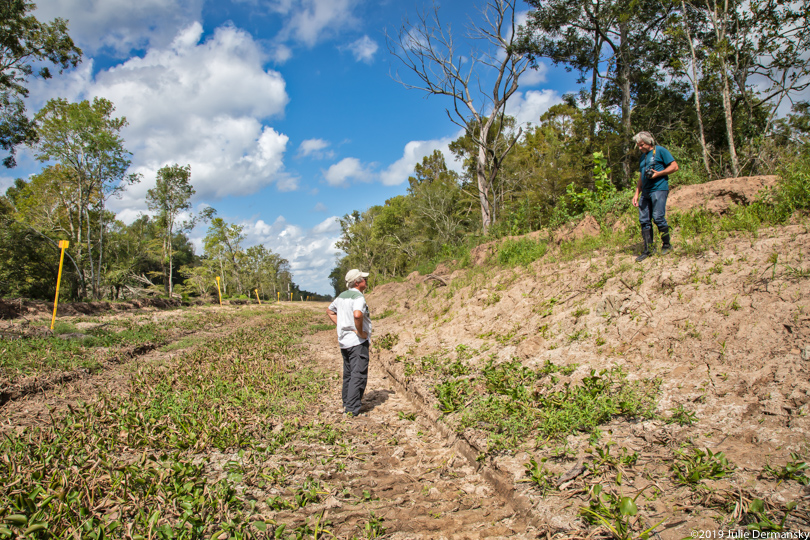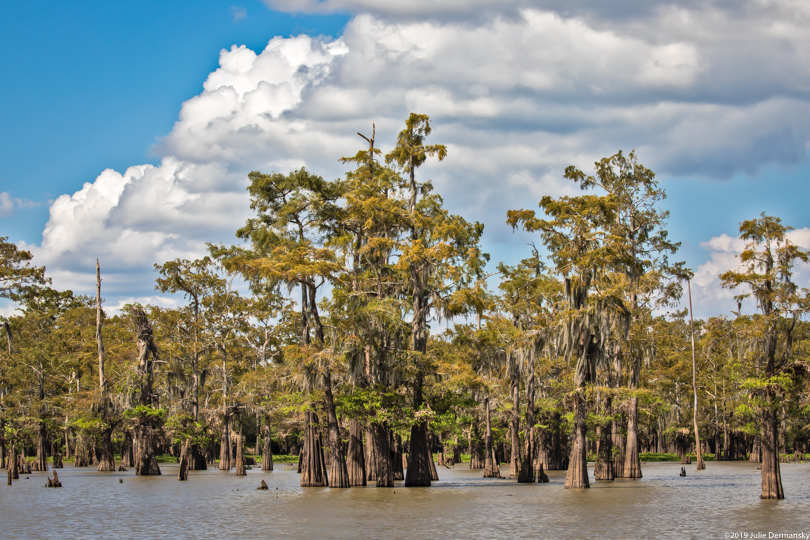“It is a crime against nature,” Jody Meche, president of the Louisiana Crawfish Producers Association-West, said while scanning the Bayou Bridge pipeline right-of-way on the west side of the Atchafalaya Basin, the country’s largest river swamp in a designated National Heritage Area.
His voice trembled with rage as he told me that he was speaking for all the animals living in the basin that can’t speak for themselves.
“The Bayou Bridge pipeline has left a dam across the Atchafalaya Basin affecting the fisheries, the birds, the otters, minks, raccoons, and nutria,” Meche said.
On September 27, I joined Meche and Dean Wilson, executive director of the conservation group Atchafalaya Basinkeeper, on a monitoring trip to the west side of the pipeline. It was their first trip along the pipeline’s construction path, which only recently became visible after unusually high water levels in the basin receded.
Jody Meche, president of the Louisiana Crawfish Producers Association-West showing me a healthy site in the Atchafalaya Basin away from the Bayou Bridge Pipeline to stress why the basin is worth preserving.
Bald Eagle in the Atchafalaya Basin.
The controversial 163-mile-long pipeline spans southern Louisiana from Lake Charles, near the Texas border, to St. James, on the banks of the Mississippi River. The Bayou Bridge pipeline is the tail end of a pipeline network built to transport Bakken oil from North Dakota to the Gulf Coast, likely for export.
An announcement on September 16 by Energy Transfer Partners, the Bayou Bridge Pipeline’s controlling owner, to acquire SemGroup, another pipeline company, sheds light on its push to export both oil and gas from America’s shale regions. The merger will “enhance export opportunities via two premier U.S. Gulf Coast Terminals,” the Energy Transfer Partners press release states. One of these export terminals is in St. James, where the Bayou Bridge Pipeline terminates.
Construction of the Bayou Bridge pipeline was completed at the end of March, despite high-water conditions, and has been operational for months.
Dean Wilson, the executive director of the Atchafalaya Basinkeeper with Ivor van Heerden and Naomi Yoder, with Healthy Gulf, next to the Bayou Bridge pipeline right-of-way.
Debris and soil left along the Bayou Bridge pipeline right-of-way interfering with a waterway in the Atchafalaya Basin.
“The destruction is even worse than I anticipated,” Wilson said, scanning piles of dirt left along the construction site that, in places, were blocking small natural waterways through the swamp.
“I knew it was going to be bad because construction should have stopped when the water got high, but I never imagined it would be this bad,” Wilson told me.
After a monitoring trip in October 2018 of the east side of the basin, when the water in the basin was about three and a half feet higher than normal, he found many navigable waterways blocked, and unbroken stretches of trenched dirt piles, known as spoil banks, restricting water flow in the basin. Wilson reported these issues to the U.S. Army Corps of Engineers, which has the authority to enforce regulations. Two weeks ago, on September 26, he was distressed to find the same waterways remain blocked off.
With documentation from several monitoring trips conducted in September, the Atchafalaya Basinkeeper, the Louisiana Crawfish Producers Association-West, and Healthy Gulf, another environmental advocacy group, filed a federal administrative complaint that accuses Bayou Bridge Pipeline LLC of a series of U.S. Clean Water Act violations in the basin.
The complaint states that they “identified numerous, significant unpermitted violations of the Clean Water Act/illegal fills, 33 U.S.C. § 1251 et seq., along the Bayou Bridge Pipeline right-of-way in the Atchafalaya Basin.” And that “the receding waters have exposed severe impacts necessitating immediate action to remediate and repair impacted areas.”
On the west side of the basin, we spotted a construction crew working on the pipeline right-of-way. Wilson explained that even if the company does fix all of the issues in the complaint he was still working on, the Clean Water Act forbids them from blocking any navigable waterway even temporarily.
“The more water restricted, the more the water quality will be affected,” Wilson said. “This is one more nail in the coffin of the basin—the biggest of all the nails.”
Scientist Ivor van Heerden stands next to the Bayou Bridge pipeline on the west side of the Atchafalaya Basin.
Dean Wilson and Ivor van Heerden stand along the Bayou Bridge pipeline route that the complaint describes as an example of “illegal fill/Clean Water Act violation along the pipeline right-of-way.”
Ivor van Heerden, a scientist who consults for the basinkeeper and formerly served as deputy director of the Louisiana State University (LSU) Hurricane Center, was on the September 26 and 27 monitoring trips. van Heerden is best known for having predicted the failure of the levees in New Orleans before Hurricane Katrina hit, and for being fired by LSU when his prediction proved to be accurate.
He was alarmed by what he saw on the recent monitoring trips, but didn’t want to comment until the pipeline company completed its restoration work.
He explained that destroying the water flow in the basin would starve the waterways of oxygen, leading to hypoxia, which kills aquatic organisms and could lead to worse flooding in the region.
Alexis Daniel, spokeswoman for Energy Transfer Partners, told DeSmog that its restoration efforts are still ongoing. “Our commitment has been and continues to be the full restoration of the areas through which we pass, in compliance with our permits.”
She would not say when the restoration work would be completed or if blocking any waterways, even temporarily, was forbidden.
Instead Daniel stated that, “restoration will continue until it is complete.”
Greg Langley, with the Louisiana Dept of Environmental Quality (LDEQ), told the Baton Rouge Advocate that issues raised in the complaint should be directed to the U.S. Army Corps, not LDEQ and had no comment. However both the Corps and the LDEQ are named in the complaint. The LDEQ was responsible for granting Water Quality Certifications for the pipeline project.
Citing pending litigation regarding the Bayou Bridge Pipeline, Ricky Boyett, a spokesperson for the U.S. Army Corps of Engineers, told DeSmog via email that the Corps had no comment.
The west side of the Atchafalaya Basin.
Main photo: Jody Meche, president of the Louisiana Crawfish Producers Association-West, monitoring the Bayou Bridge Pipeline on Sept. 27, 2019.
Subscribe to our newsletter
Stay up to date with DeSmog news and alerts


